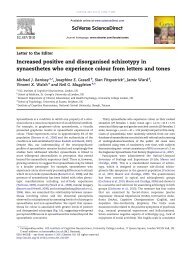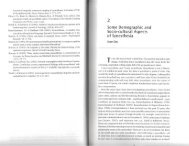A strong parietal hub in the small-world - Synesthesia
A strong parietal hub in the small-world - Synesthesia
A strong parietal hub in the small-world - Synesthesia
You also want an ePaper? Increase the reach of your titles
YUMPU automatically turns print PDFs into web optimized ePapers that Google loves.
Small-<strong>world</strong> network of coloured-hear<strong>in</strong>g synaes<strong>the</strong>tes 193<br />
The frequency bands<br />
Most <strong>hub</strong>s were identified for <strong>the</strong> alpha band (alpha1 and alpha2). In general, alpha<br />
power and bra<strong>in</strong> activity are <strong>in</strong>versely related (i.e., an <strong>in</strong>crease <strong>in</strong> alpha power <strong>in</strong>dicates<br />
a decrease <strong>in</strong> bra<strong>in</strong> activity) (Laufs et al., 2003a). The power of <strong>the</strong> alpha rhythm<br />
with<strong>in</strong> a particular bra<strong>in</strong> area has been shown to be directly associated with <strong>the</strong><br />
functions controlled by <strong>the</strong>se areas. For example, alpha rhythm <strong>in</strong> parietooccipital areas<br />
is modulated by attentional factors and vigilance, while <strong>the</strong> alpha rhythm with<strong>in</strong> <strong>the</strong><br />
auditory cortex (<strong>the</strong> so-called tau rhythm) varies as a function of auditory stimulation<br />
(Hari & Salmel<strong>in</strong>, 1997; Hari, Salmel<strong>in</strong>, Makela, Salenius, & Helle, 1997). F<strong>in</strong>ally, alpha<br />
rhythms are broadly l<strong>in</strong>ked with perceptual process<strong>in</strong>g and memory tasks (Klimesch,<br />
1999; Klimesch, Freunberger, & Sauseng, 2010; Rihs, Michel, & Thut, 2009; Thut,<br />
Nietzel, Brandt, & Pascual-Leone, 2006), as well as be<strong>in</strong>g specifically l<strong>in</strong>ked with<br />
hippocampal activity dur<strong>in</strong>g memory tasks (Babiloni et al., 2009). Theta rhythms <strong>in</strong><br />
<strong>the</strong> extrastriate areas have been identified <strong>in</strong> association with short-term ma<strong>in</strong>tenance of<br />
visual <strong>in</strong>formation <strong>in</strong> monkeys (Lee, Simpson, Logo<strong>the</strong>tis, & Ra<strong>in</strong>er, 2005). Beta rhythms<br />
have been observed <strong>in</strong> normal subjects dur<strong>in</strong>g states of higher arousal, such as <strong>in</strong>duced<br />
anxiety (Isotani et al., 2001), but also dur<strong>in</strong>g imag<strong>in</strong>ation, preparation, or observation<br />
of motor actions; thus, <strong>the</strong> beta rhythm, especially when it reflects activations of <strong>the</strong><br />
premotor, motor, or sensorimotor system, is thought to represent <strong>the</strong> activation of <strong>the</strong><br />
mirror neuron system (Hari 2006; P<strong>in</strong>eda, 2005). The orig<strong>in</strong> of spontaneous rest<strong>in</strong>g beta<br />
rhythm is not well understood, although it appears to be modulated by <strong>the</strong> GABA-ergic<br />
system ( Jensen et al., 2005). Taken toge<strong>the</strong>r, <strong>the</strong> EEG rhythms associated with <strong>the</strong> <strong>hub</strong><br />
regions of <strong>the</strong> coloured-hear<strong>in</strong>g synaes<strong>the</strong>tes <strong>in</strong>dicate neural processes that are known<br />
to be <strong>in</strong>volved <strong>in</strong> controll<strong>in</strong>g particular psychological functions (perception, memory,<br />
executive control, as well as sensorimotor control) and have been previously associated<br />
with synaes<strong>the</strong>sia.<br />
Limitations of <strong>the</strong> study<br />
Several limitations of this study should be addressed. First, we were not able to<br />
discrim<strong>in</strong>ate between associators and projectors. This would have been very helpful<br />
s<strong>in</strong>ce recent studies have demonstrated that both synaes<strong>the</strong>sia subtypes differ <strong>strong</strong>ly<br />
<strong>in</strong> terms of anatomical features and bra<strong>in</strong> activation (Rouw & Scholte, 2007, 2010). In<br />
future studies, we plan to disentangle possible different rest<strong>in</strong>g state EEG patterns for<br />
associators and projectors. Second, <strong>the</strong> relatively low number of electrodes used for<br />
this study needs to be considered because <strong>the</strong> precision of estimation of <strong>in</strong>tra-cerebral<br />
sources <strong>strong</strong>ly depends on <strong>the</strong> number of electrodes (Lantz, Sp<strong>in</strong>elli, Menendez, Seeck,<br />
& Michel, 2001; Michel et al., 2004). Although several studies have demonstrated that<br />
<strong>the</strong> precision of estimated <strong>in</strong>tra-cerebral sources based on 32 channels (as used <strong>in</strong> our<br />
study) is fairly good and at least roughly corresponds with fMRI results (Mulert et al.,<br />
2004), caution is warranted when mak<strong>in</strong>g <strong>strong</strong> arguments about <strong>the</strong> exact localization<br />
of <strong>the</strong> identified <strong>hub</strong>s.<br />
However, we would like to emphasize that James and colleagues reliably identified<br />
hippocampal activity dur<strong>in</strong>g memory tasks (James, Britz, Vuilleumier, Hauert, & Michel,<br />
2008; James, Morand, Barcellona-Lehmann, Michel, & Schnider, 2009). In addition, Lantz<br />
et al. (2001) even demonstrated that hippocampal foci of epileptic seizures can be<br />
detected even with 31 electrodes relatively precisely with a spatial error of approximately<br />
2 cm. A fur<strong>the</strong>r set of evidence has been added by Zumsteg and colleagues us<strong>in</strong>g PET<br />
simultaneously with EEG-based LORETA solutions (Zumsteg, Friedman, Wennberg, &




